I started to like memecoins and even bought MOODENG.
It was the fear of missing out (FOMO). My default expectation was that the price would drop to 0, but I didn’t want to miss the chance to become the next Doge. I wanted to be part of the success story and be part of that bullish community.
Indeed, buying memecoins, more than buying other utility tokens, stems from an intrinsic need to belong, to be part of a story, to join a community that shares the optimism of “achieving the dream.”
It’s important to understand that this kind of optimism and bullish sentiment is hard to find in other cryptocurrency spaces.
Ethereum holders expect ETH to only rise 3-4 times in this cycle, and BTC may be similar. SOL may reach $1,000. For tokens with low circulation and high fully diluted valuation (FDV), the overall sentiment is quite pessimistic.

This also goes against my promise not to trade meme coins. I won’t buy most of the meme coins that are recommended on platform X, but I will try to buy some that I think have the potential to take off.
I changed my mind because the most important principle for me in cryptocurrency investing is to keep an open mind and be willing to try new things. It is dangerous to be an extremist (a believer in only one investment strategy or coin), but identifying and investing in those extremist communities can bring huge rewards.
Therefore, this blog post will explore the latest developments, particularly around emerging token issuance methods.
Identifying the latest token issuance trends can be one of the most profitable trades we can make. Memecoins are just one of the trends, and there are others emerging in this cycle.
A brief history of token issuance
“Crypto is a hedge against fiat money printing” is the biggest lie we tell.
While Bitcoin may be an exception, the entire crypto industry is printing money in a way that would make even central banks envious. There are currently 14,741 cryptocurrencies listed on CoinGecko, and there are thousands of crypto projects that simply don’t survive to be included.
And with each cycle, issuing tokens becomes easier.
I wrote in detail about the history of token launches and what to expect from this bull run in my article from a year ago, but since that blog post is now only available to paid subscribers, I have to quickly recap it here.
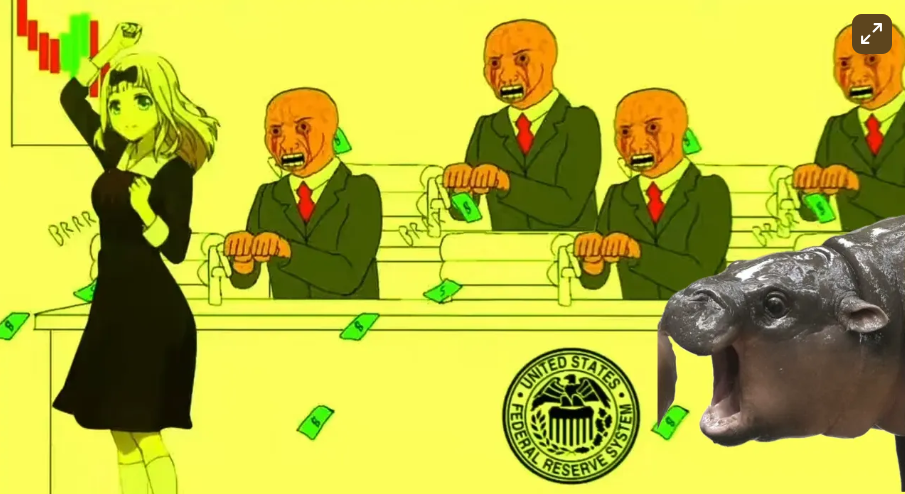
Echoes of the past: What familiar markets tell us about the next bull run
Here are a few key “money printing” patterns you need to know about and their impact on the market landscape (if you’ve already read my previous blog post, you can skip this section).
1. Litecoin and early Altcoin era (2011) :
Litecoin is one of the earliest Altcoin, created in 2011 as a fork of Bitcoin. Before Litecoin, people thought that Bitcoin was all there was to blockchain! However, the Litecoin fork not only changed the technical consensus, but also "forked" people's understanding of private currency - that we can create our own cryptocurrency. This period has seen the birth of several Bitcoin forks and a handful of Proof of Work (PoW) Altcoin, including Bitcoin Cash and Bitcoin SV. These forks brought "free" tokens to Bitcoin holders at the time of the fork, creating new arbitrage opportunities.
2. ICO boom (2017) :
The ICO (Initial Coin Offering) boom was driven by Ethereum’s ERC20 standard, which drastically reduced the cost and difficulty of creating new tokens. No more PoW hardware mining! Thousands of new tokens emerged, each with ambitious promises. ICOs were often able to raise huge amounts of money, but many projects failed to deliver on their promises, leading to huge losses after the 2018 market crash. This phase was a classic case of speculative “money printing” — teams were able to launch new tokens with very little effort, which ultimately led to an over-expansion of the market and a crash.
3. DeFi and Liquidity Mining Era (2020) :
The next wave of innovation came in the DeFi summer of 2020, when liquidity mining and yield farming became popular. Projects like Compound (COMP) and SushiSwap introduced liquidity mining reward mechanisms, where users receive governance tokens by participating in the protocol. This model incentivized liquidity supply and user participation, but the excessive issuance of new tokens eventually exceeded market demand, leading to the subsequent market crash.
4. Fair issuance era :
This era was short-lived. Yearn Finance’s YFI token is a classic example of the concept of “fair issuance”, where tokens were distributed directly to users without an ICO or presale. This allowed anyone to participate, and YFI’s initial liquidity mining rewards attracted widespread attention. However, the community soon discovered that the so-called “fair issuance” was not really fair. Many teams pre-mined before marketing, and the fair issuance model did not bring enough benefits to the team, resulting in a deviation in the incentive mechanism.
5. NFT and Ponzi economic model (2021) :
NFT mania, represented by Bored Ape Yacht Club, has ushered in a new mode of “printing money”. A steady stream of new NFT series mimics the speculative token creation model that previously led to the market crash. A large amount of funds and attention were scattered to various emerging NFT projects, which eventually led to the collapse of many new NFT projects. NFTs are like meme coins, but the upper limit of 10,000 NFTs per series and the high selling price limit the size of the community, excluding many investors.
Although the ways of "printing money" in the market vary, whenever the amount of "printing money" exceeds the "hard currency" entering the market, the market will eventually collapse.
In this process, we issued too many tokens, and the market demand was difficult to digest, which eventually led to the bursting of the market bubble.
The Money Printing Story of the 2023-2024 Bull Market
The first phase of the current bull run was marked by the rise and fall of the points airdrop trend.
The Points meta-game evolved naturally to solve some of the liquidity mining problems. By providing teams with more flexibility to execute TGEs (token generation events) and attract capital into the protocol, it drives TVL (total value locked) growth and "proves" product-market fit. This, in turn, enables teams to obtain higher valuations from venture capital (VC).
Initially, this trend worked well with projects like Jito and Jupiter that generously rewarded users, however once the rules of the points airdrop meta-game became clear, the return on investment (ROI) of airdrops often turned negative.
Some users use mining to earn points, but often end up paying more in interest than they earn from the airdrops. In addition, the points system lacks the transparency that liquidity mining activities enjoyed during the DeFi summer.
They lead you to believe that by staking “DYM” or “TIA” you will receive multiple airdrops (which never came) to make you rich.
However, the worst culprit that marks the decline of this trend is the issuance of tokens with low circulating supply and high fully diluted valuation (FDV). As TVL grows, the market deems these protocols to be more valuable, so tokens are issued at crazy high valuations without any upside for new buyers.
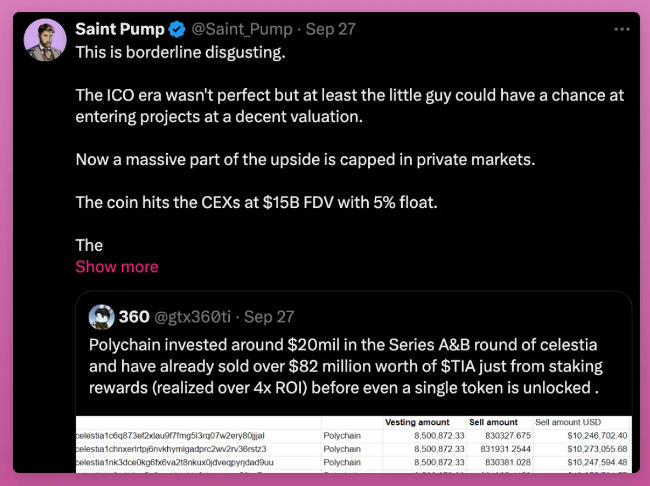
High fully diluted valuations (FDVs) are no joke, here’s what we learned.
Points aren’t going away completely, but a decline in sentiment and usage is creeping in. For example, Eigenlayer decided not to do a season 3 airdrop, opting instead for “programmatic incentives,” a fancy way of saying what is effectively liquidity mining.

Most major protocols are now entering their second, third, or even fourth “points farming season”. Enthusiasm for point farms launched by new protocols has also waned. I used to share “farms of the week” regularly on this blog, but now I find it difficult to find ideal point farm opportunities in the market.
New protocols that missed the “points boom” have to innovate in their token issuance models to try to attract users and create a wealth effect. Here are some of the new “money printing” models that are emerging:
Public and Private Token Sales
The ICO is dead. Long live the ICO.
Cobie, perhaps the most influential cryptocurrency trader currently, wrote in his May blog that the problem with the current crypto market is that new token launches are nearly unaffordable for the average participant to invest in due to the “capture” of “private gains.”
Most price discovery occurs in private funding rounds with venture capitalists (VCs), who lock up tokens at low prices before they are publicly available. As a result, when these tokens come to market, they are often already overvalued, with inflated fully diluted valuations (FDVs), leaving little room for profit for public investors. This situation benefits insiders while public investors are exposed to high-risk, low-return investment opportunities.
For example, the valuation of ETH during its seed round or ICO left investors with huge room for upside.

However, this is no longer true for low circulation, high fully diluted valuation (FDV) tokens like STRK, EIGEN, or other low circulation, high fully diluted valuation (FDV) tokens of this cycle.
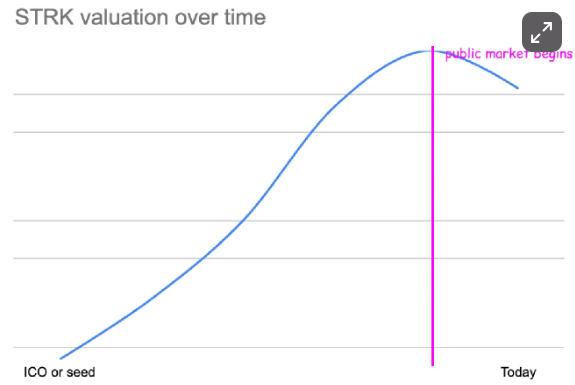
Therefore, Cobie’s solution is to launch Echo, a platform focused on early-stage token investments.
How Echo works:
1. Team Leader :
“Experienced investors” (or opinion leaders, KOLs) create groups and share investment opportunities with members. Group members can choose to follow and invest under the same terms as the group leader.
2. On-chain investment :
All investments are made in USDC on Base L2.
3. Smart Contracts :
Investments are legally managed by Echo through smart contracts, so group leaders do not directly handle your funds. Only you can decide when to sell your tokens (in the case of token investments).
4. For founders :
Founders who want decentralized, community-driven financing can raise funds through Echo groups, avoiding concentrated VC ownership and distributing equity or tokens to true, on-chain native investors.
To participate, you need to pass KYC, connect your X or Farcaster account, complete a questionnaire, and then join the group to view investment opportunities.
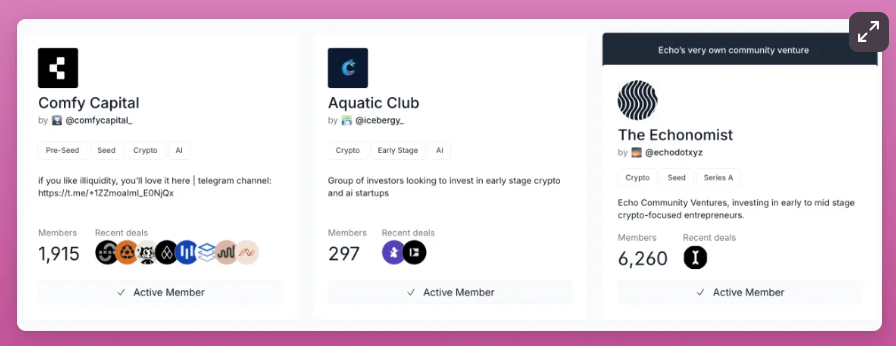
Their first major deal was Initia, which raised $2.5 million from at least 500 participants at a valuation of $250 million, 28.57% lower than the $350 million valuation in the Series A round (as reported by The Block). The maximum investment per participant was $5,000.
It’s great that Echo participants were able to invest at a price below the Series A valuation. But the concept is very much a throwback to the early ICO model of the past, which many of us missed out on.
Of course, I can create my own group and invite my followers to co-invest in early-stage protocols. Compared with venture capital (VC) rounds, these protocols can benefit from a larger community, but this does not solve many of the pain points faced by projects, such as larger capital injections, industry connections, strategic guidance, marketing and credibility, and long-term support.
Nonetheless, I believe projects could benefit from multiple sources of funding: first getting significant backing from a well-known VC, then later raising a community-building round through Echo, as Initia did.
However, Echo is currently an exclusive community, which is precisely what makes it so profitable: most popular ICO platforms, such as Coinlist, are difficult to enter and have very small allocation sizes.
If you can get involved, give it a try.
Patron Sales
I have only participated in two KOL financing rounds: Bubblemaps and Vertex.
Recently, I sort of participated in the third round of financing: Infinex. I say "sort of" because this is not a typical KOL financing round.
In a typical KOL funding round, influencers are offered an “investment opportunity” on terms that are better than what is offered to venture capital (VC). The problem? KOLs need to post a few tweets about the project on social media. The lack of these promotional conditions attracted me to Bubblemaps and Vertex. But if I don’t promote, what’s the point of being an investor?
Synthetix’s Kain took a different approach with the Infinex token sale.
In addition to running gamified yield farming campaigns, he also conducted sponsored NFT sales. I received a private message from Kain, telling me that I could invest by choosing one of three lock-up and valuation terms: unlock, unlock annually, or 1 year cliff period plus 2 years unlock, with a 75% discount.

Infinex Raised $65 Million from 41,000 Backers!
In a podcast with Blockworks, Kain noted that the current common method of token distribution, which relies primarily on airdrops and private sales to accredited investors, is flawed.
He advocates for a fairer approach, arguing that everyone from venture capital (VC) to influencers and regular investors should have an equal opportunity to purchase tokens at the same price.
“Everyone is on an equal playing field. That’s the best thing you can do, right? If everyone has the same rules, you make information as available as possible. You prevent certain people from rushing in out of fear of missing out and not knowing what’s going on.” — Kain
Like Echo, Infinex found inspiration in the ICO era and the points farming trend, but adapted it to the needs of the current era. Yes, many participants are influential CT people, so this sale excludes a large community. But there are different ways to qualify for the sale (points farming).
Unfortunately, this model may not work for less popular projects. However, if more token sales offered no-strings-attached KOL sales with an opt-in option on the website, rather than requiring an unclear SAFT contract with an unclear TGE timeline, I would absolutely participate in more token sales.
However, there is a new trend that allows anyone to participate in token sales.
Application of Runes or other token models to Bitcoin
Personally, BTCfi is the most exciting 0 to 1 innovation in crypto this cycle. I'm having a ton of fun minting Ordinal NFTs and playing with BRC20/Rune tokens.
I admit that the infrastructure and user experience (UX/UI) are not perfect, but they are gradually improving. However, ORDI (the first BRC20 token) was minted for free and reached a market cap of $1.8 billion, bringing amazing profits to early adopters. This is the success story we should chase!
I also held ORDI but sold it too early...
BTCfi was one of the hottest narratives, but the hype ended soon after the launch of the Runes protocol.
Nevertheless… I still believe BTCfi can do well: the infrastructure is improving, the community is strong (and mostly in Asia, so you hear less about BTCfi on CT). The price is also recovering. Take a look at the performance of the top 10 runes in the past 7 days.
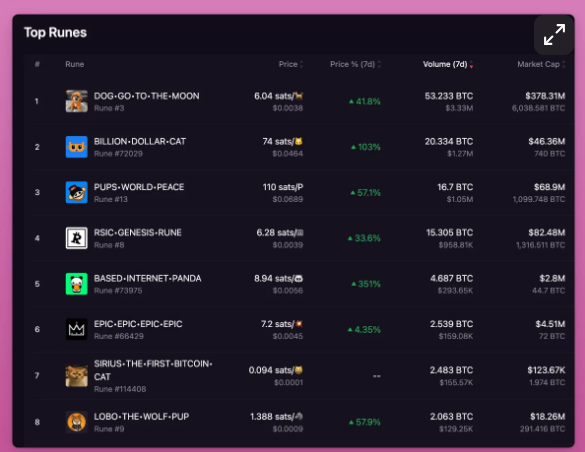
However, the most important BRC20 and Runes innovation is how they are released to the market.
Anyone can mint rune tokens on Bitcoin, just pay the transaction fees in Bitcoin. If you want to try it, you can go to Luminex and choose a token to mint. Or you can launch your own memecoin and choose a percentage of the premine. This premine will be clearly visible to everyone.
I am optimistic about Runes because they counter everything we are unhappy with about venture capital rounds, pre-sales, low circulating supply of tokens, and the lack of transparency in the current memecoin distribution. Runes represent the fairest token distribution model available.
Additionally, the smaller Bitcoin transaction fees and very slow transaction speeds add just enough friction for over-issuance and concentration of tokens in a small number of wallets, avoiding the issues faced by other on-chain memecoins.
I believe a new catalyst is needed to spark a new wave of FOMO.
Fractals L2 is gaining traction right now, so it could potentially create heat for runes, since runes can be minted first on Bitcoin and then bridged to Fractals (or other Bitcoin L2) where they can gain smart contract capabilities.
By the way, Fractal's token FB is mined like Bitcoin, and you can participate in cloud mining by renting PoW machines. Due to high inflation, the price of FB can only go down.
Finally, new Bitcoin token standards may emerge, perhaps through the OP_CAT upgrade to enable innovative token models.
My point is that there is huge speculative potential in tokens issued fairly on Bitcoin and it is worth your time to pay close attention to the BTCfi ecosystem.
Click to Earn: Ton Mini App
Clicking on my phone screen isn't my favorite way to make money.
However, the click-to-earn mini-apps enabled by TON and Telegram have attracted millions of users. These users are usually not in the United States, so most people in the crypto (CT) world have missed out on this new trend.
In my previous article, we discussed what makes South Asia a unique crypto market.
We understand that for many people in developing countries, click-to-earn airdrops offer an opportunity to earn new income amid economic challenges. This better aligns with the promise of blockchain, which aims to make cryptocurrency accessible to everyone, not just the wealthy who would benefit most from the click-to-airdrop model.
But after the DOGS, Catizen, and Hamster craze, it is unclear what will come next. All tokens are currently in sell-off mode, so a new catalyst is needed to attract new "degen" crowds to participate in the TON mini-app.
Be the first to notice trend changes to maximize profits.
Memecoins
Memecoins are tokenized communities.
Murad does an excellent job of articulating the value proposition of memecoins in the video below. He clearly explains how memecoins are superior to many utility tokens in the current state of the market (e.g., VC unlocking, lack of transparency, regulatory issues, etc.).
However, he only presents one side of the memecoin story.
However, he only shows one side of the memecoin story.
His screenshots show the superior performance of memecoins, but ignore that 99.5% of memecoins will fall to zero in a day or two.
Contrary to his optimistic view, memecoins are often launched by internal teams with large pre-mined supplies and promoted by KOLs (key opinion leaders) who are either paid or given large allocations and ready to dump on new buyers.
It has no real community. It just sells the illusion of a community. This is why I stay away from memecoins: it is troublesome and time-consuming to find the real gems in a pile of garbage. Jumping back and forth between different memecoins can quickly burn your capital. Therefore, it is wiser to hold Bitcoin.
Despite this, memecoins are the sector with the most optimistic community in the crypto space. This greed is the key breeding ground for true gems, a Doge competitor may emerge. This is why I haven't given up on memecoins 100%.
Additionally, during this cycle, platforms like Pumpdotfun have addressed initial liquidity issues by introducing a fairer issuance mechanism to prevent insider trading, using dynamic bonding curves, and mitigating many security risks.
Investing in memecoin launch platform tokens might be a good option, like Ethervista or the upcoming Rush platform. I know the Rush development team, so it's not a scam. You can join the waitlist using my link. However, be careful: Ethervista's token has been falling since its launch.
Repack + New Tokens
Old coins are boring, and the “degens” want something new.
What if you could change your brand name, create a new token ticker, and start over with a new chart? That’s exactly what’s happening right now. I first wrote about this trend in June.
We saw multiple rebrands, such as MATIC changing its name to Polygon and launching a new token POL, Orion changing its name to Lumia (ORN becoming LUMIA token), Covalent (a decentralized protocol for the AI era) moving from CQT to CXT tokens, Connext rebranding to Everclear (and introducing a new token economy), and many other examples!
The most interesting examples are Fantom’s migration of $FTM to $S and Arweave’s launch of the AO protocol.
Arweave decided to launch a new token for the AO protocol (AO) instead of using AR. This makes sense since AO is a different protocol, but the highlight is that AO tokens can be mined by simply holding AR in a wallet. It's like a "money printing machine"!
Unfortunately, the performance of these rebranded tokens does not offer much hope for this trend. Perhaps only Fantom’s rebrand is thriving, while even Polygon is struggling during this cycle.
Still, keep an eye out for rebrands that spark community interest. This shows that the team is still here, hasn’t abandoned the protocol, and is still developing it.
Community/Social Tokens
Damn FriendTech and 0xRacer.
This was one of my biggest mistakes this cycle.
They had the opportunity to build a consumer-grade app that could have outgrown the crypto “Degen” crowd, but they chose the shortcut of deceiving their users.
Regardless, FriendTech has transformed the industry by normalizing the use of Privy, improving the user experience, and making social tokens popular.
In FriendTech’s v1, social tokens were based on KOL (Key Opinion Leader) personalities, while in v2, the goal is to tokenize communities.
Like “Memecoins”, community tokens are built around communities and provide access to exclusive clubs.
The most successful example is the DEGEN token, which was recently listed on Coinbase and is up 127%! Initially, it was a community token airdropped to active Farcaster members. Personally, I made about $40,000 by posting on Warpcaster.
The beauty of DEGEN is its community-driven launch and its integration with Farcaster, which is made possible by the open nature of the platform. Tokens like DEGEN reward participation, helping solve the classic "chicken and egg" problem of social platforms: users don't post because there aren't enough users. Other social apps could adopt a similar strategy by generously rewarding early members. Lens also had its own airdrop.
My point is to try new decentralized social applications like Phaver (I did a few posts on it and also received a $250 airdrop).
However, their usefulness in specific applications has limited their adoption. DEGEN decided to launch its own L3 to scale, so keep an eye on other community tokens’ decisions.
What’s more worth watching: we’ll likely see the launch of Farcaster, Lens, OpenSocial, and other SocialFi tokens.
What should we pay attention to in this bull market?
The best returns often occur at the beginning of an emerging trend. Liquidity mining, points farming, fair launches, and NFT minting have created millions for early adopters. My mission is to identify these new token minting trends and find ways to capitalize on them.
A good sign of high potential is initial confusion in the community mixed with love or hatred. As long as people care, keep paying attention.
Study how this token minting creates a flywheel effect, rewarding early users and incentivizing them to stay in the ecosystem. This may look like a Ponzi scheme, but the best "money printing mechanisms" often have similar characteristics.
Also, remember to always keep an open mind. Try new things, and if you discover something interesting, feel free to let me know!








